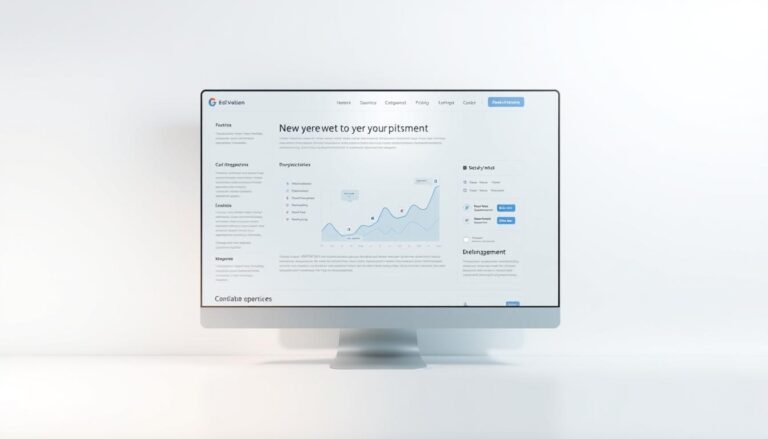Today, companies are stepping up their game by using automated sales prospecting. This method uses tech tools to find, engage, and turn leads into dedicated customers faster. By adding it into their sales plan, businesses can find high-value prospects more effectively than using old-school methods.
It’s all about being more efficient and tailoring approaches to each customer. This reduces the time spent on tasks that happen over and over. Thanks to better data collection and analysis, firms can connect with potential clients that fit their ideal customer profile. This gives them an edge in a market that’s always changing.
Key Takeaways
- Automated sales prospecting enhances efficiency in lead generation.
- It allows for better targeting of high-potential prospects.
- The approach reduces time spent on repetitive tasks.
- Data analytics play a crucial role in identifying ideal customers.
- Companies gain a competitive advantage by embracing automation.
Introduction to Automated Sales Prospecting
Automated sales prospecting is changing how companies find customers. By using automation tools, they make their work easier and focus on talking to leads. This is very important now because the market is competitive. Customers have many choices and want fast, personalized responses.
What is Automated Sales Prospecting?
Automated sales prospecting means using technology to find and talk to potential customers better. It uses special tools that help sales teams connect with leads quickly and correctly. These tools cut down on manual work. This lets salespeople focus on the most important parts of selling.
Importance in Today’s Market
In today’s competitive world, automated sales prospecting is key for doing well. Companies that use sales intelligence platforms respond to customers faster. This is important because customers want quick replies. With automation, companies keep in touch regularly and look after leads well.
Maintaining a strong pipeline gets easier, helping sales teams do really well. This new method uses data to make smart sales choices. It meets the changing needs of buyers. For more on this, check out this resource.

Benefits of Automated Sales Prospecting
Automated sales prospecting can greatly improve sales performance and help companies grow. It lets sales teams keep up with changing buyer behaviors and market demands. These advantages are key in today’s fast-moving business world.
Improved Efficiency and Time Management
Automatic lead generation makes sales teams more efficient and better at managing their time. Salespeople often do the same tasks over and over, which takes up a lot of time. Automation sorts leads by how likely they are to buy.
This lets teams focus on the most promising prospects. They use their time more wisely, targeting efforts where they count the most.
Higher Lead Conversion Rates
Using AI in sales prospecting can help turn more leads into customers. It does this by reaching out to people who are already interested. Sales teams can send these leads special messages and offers that fit what they’re looking for.
With data, sales teams understand their clients better. This leads to stronger relationships and more sales. Automated systems have been shown to improve the rate at which leads become customers.
Enhanced Data Analysis Capabilities
AI tools give companies deeper insights into what customers want and how they behave. This information helps sales teams predict what buyers will do next. Automation fills the sales process with up-to-date, relevant information.
This lets teams improve their strategies over time. Companies that use AI for sales prospecting often do better in their markets. For more on these tech benefits, visit this resource.

Tools for Automated Sales Prospecting
To use automated sales prospecting well, you need the best tools. Many software options are available, each bringing unique benefits to the table. These tools let organizations pick what matches their needs and make the most of automation.
Popular Software Solutions
Here are the top picks for automated sales prospecting:
- HubSpot – Offers an all-in-one platform with features for CRM automation and automated lead scoring.
- Salesforce – Renowned for its robust capabilities that integrate well with existing customer data and outreach strategies.
- Pipedrive – Focuses on intuitive user experience, providing excellent tracking and management of leads.
Features to Look For
When choosing a tool, it’s crucial to know which features will aid your sales the most. Important features to consider include:
- Automated Lead Scoring – Prioritize leads based on their likelihood to convert, ensuring teams focus efforts where they matter most.
- Integration Capabilities – Seamless connection with existing CRM systems provides a unified approach to managing customer interactions.
- Customizable Email Templates – Facilitate personalized outreach that engages prospects effectively.
- Advanced Analytics Reporting – Track campaign performance and optimize based on data insights.
Integrating Tools with Existing CRM Systems
Linking automation tools with your CRM system makes lead management more efficient. This ensures smooth data flow and lets sales reps track interactions and update records easily. When different platforms work well together, it can improve how you manage and convert leads.
Best Practices for Implementing Automated Sales Prospecting
To get the best outcomes from automated sales prospecting, it’s important to stick to key strategies. Start by knowing who you’re selling to. By understanding your audience, you can create messages that speak to their wants, likes, and needs. This approach makes your efforts more effective.
Defining Your Target Audience
Knowing your audience means you can tailor your communication. With sales pipeline automation tools, teams can collect data for personalized campaigns. This focused method boosts the chances of people responding and buying.
Utilizing Multi-Channel Approaches
A multi-channel strategy opens more doors to connect with potential customers. By reaching out through emails, social media, and targeted ads, the experience for prospects gets better. Keeping your message the same across all platforms strengthens your brand and ups your visibility, making sales prospecting more powerful.
Regularly Updating and Maintaining Lists
Keeping data up-to-date is key for successful automated sales prospecting. By frequently refreshing lists, you give your team the latest information. Adding automated lead scoring helps salespeople focus on leads most likely to buy, boosting efficiency.
Discover more ways to enhance your sales strategy by diving into advanced predictive sales pipeline forecasting techniques.
| Practice | Description | Benefits |
|---|---|---|
| Define Target Audience | Identify specific demographics and characteristics. | Improves targeting and personalization. |
| Multi-Channel Engagement | Use various platforms for outreach like social media and email. | Increases visibility and brand recognition. |
| Data Maintenance | Regularly update lead lists and information. | Ensures accuracy and relevance in communication. |
Measuring Success in Automated Sales Prospecting
To measure automated sales prospecting success, look at Key Performance Indicators (KPIs). Businesses use KPIs to set benchmarks for checking performance. They track things like how many leads buy something (conversion rates), how quickly a team responds, and how interested potential clients are (lead engagement levels). These are key to understanding how effective your sales efforts are.
Key Performance Indicators (KPIs)
Choosing the right KPIs is crucial when using CRM automation and sales intelligence tools. Conversion rates show the percentage of leads that turn into customers. Response times show how fast the sales team connects with prospects. Lead engagement levels tell us if our marketing grabs interest. Together, these metrics paint a clear picture of how well you are reaching potential customers.
Analyzing Campaign Results
Analyzing campaign results means looking closely at the data from different tools. Companies can see which strategies work well and which ones don’t by examining customer actions and trends in engagement. This deep dive into analytics helps make smart decisions about sales strategies.
Adjusting Strategies Based on Data Insights
To get better at automated sales prospecting, you need to be willing to change tactics based on data. Tweaking strategies helps improve current campaigns and makes them more effective. Being open to change ensures companies get the most from their sales prospecting investments, staying competitive in a rapidly changing market.
FAQ
What is automated sales prospecting?
Automated sales prospecting uses technology to find and attract leads, turning them into customers more efficiently. It boosts sales pipelines and cuts down on repetitive work.
Why is automated sales prospecting important in today’s market?
It helps businesses quickly connect with potential customers in a competitive market. This tech keeps companies ahead by meeting consumer demands for fast responses.
What are the key benefits of automated sales prospecting?
Main benefits are better efficiency, more leads becoming customers, and improved data analysis. It helps sales teams focus on promising leads and understand customer behavior better.
What software solutions are popular for automated sales prospecting?
HubSpot, Salesforce, and Pipedrive are leading tools. They offer powerful features that help manage lead data and streamline outreach efforts.
What features should businesses look for in prospecting automation tools?
Look for tools that score leads automatically, work well with current CRM systems, provide customizable emails, and offer detailed analytics. These features improve sales operations significantly.
How can businesses effectively implement automated sales prospecting?
Successful implementation involves knowing your target audience, using various channels, and keeping lead lists up-to-date. This ensures outreach efforts are targeted and leads remain relevant.
What are Key Performance Indicators (KPIs) in automated sales prospecting?
KPIs like conversion rates, how fast you respond, and how well leads engage are crucial. They show if your prospecting is working and where to adjust.
How can companies analyze and adjust their sales prospecting strategies?
By using analytics tools to review campaign results and understand customer interactions. This helps companies fine-tune their strategies for better investment returns.



